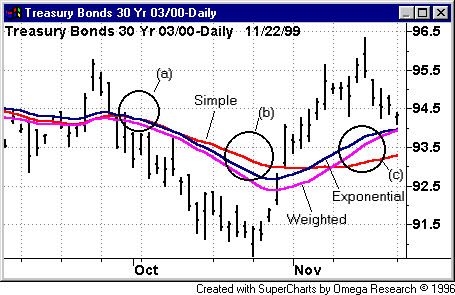Hard Right Edge David Landry Moving Averages The Ins Outs Of
Post on: 20 Июль, 2015 No Comment

By David Landry
The moving average is probably one of the most used and possibly overused indicators in the financial markets. In the first of this three-part series we will look at the calculation and comparison of simple, exponential and weighted moving averages.
Simple Moving Average
An average is simply the sum of a data set divided by the number of data points. Let’s look at a set of grades. Suppose Johnny earns the following grades:
67 77 80 82 85
His average would be the sum of the grades divided by the number of tests:
(67 + 77 + 80 + 82 + 85)/5 = 391/5 = 78.20
Now suppose on his next test he scores a 90. If we took a 5-day moving average of his grades we would drop off his oldest grade (67) and add in his newest grade (90) and then divide by 5. This is illustrated in Figure 1. Notice how the average moves from the oldest 5 data points to the newest 5 data points, hence the name moving average.
Figure 1: A 5-Period Simple Moving Average. Notice how the average moves from the oldest 5 periods to the newest 5 periods.
Exponential Moving Average
An Exponential Moving Average (EMA) takes a percentage of today’s price and adds in the prior day’s exponential moving average times 1 minus that percentage. For instance, suppose you wanted a 10% EMA. You would take today’s price and multiply it by 10% then add that figure to the prior day’s EMA multiplied by the remaining percent:
(today’s close * .10) + (yesterday’s exponential moving average * (1-.10)).
Because most people think in terms of days (time periods) versus percentages, the following formula can be used to determine the percentage to be used in the calculation:
Exponential Percentage = 2 /(Time Periods + 1).
So if you wanted a 20 period EMA you would use 9.52% (2/(20+1)) as your percentage for the calculation.
As usual, I strongly suggest that you have a computer do all the work, since the EMA is available in virtually all charting packages. I have yet to meet a trader that does these calculations by hand. As you can see, by nature of its calculation, the EMA gives more weight to the recent periods. This brings us to our next type of moving average: the weighted moving average.
Weighted Moving Average
The theory behind a weighted moving average (WMA) is that the recent data is more relevant than past data. Therefore, it puts more weight on the recent data and less weight on the older data. To calculate it, you take the number of periods you wish to analyze and that becomes the weight for today’s price. Yesterday’s price would use today’s weight -1 and so on and so forth for the number of periods. You then divide the sum of the weighted prices by the sum of the weights.
For example, suppose we took the last five grades we used in our first example and calculated a 5-period WMA. The calculation would be as follows:
Figure 2: Calculation of a Weighted Moving Average. The number of periods (in this case 5) becomes the weight for today. The weight for the remaining days is reduced by 1 until the last day is found. Therefore, the most recent period gets the highest weight and the oldest period gets the smallest. The summed weighted prices are then divided by the sum of the weight.
Again, I strongly suggest that you have your computer do all the work.
Comparing the EMA,WMA and Simple Moving Averages
The simple moving average gives equal weight to all data points. By nature, it is the true average. The exponential and weighted moving averages give the most recent data points the highest rankings or weightings. Therefore, the simple moving average tends to lag (by representing all data points equally) the exponential and weighted moving averages during large price changes. However, during normal or flat markets the differences become negligible. This is illustrated in figure 3.
Figure 3: March 2000 Bonds with 50-day Simple, Exponential and Weighted Moving Averages. Notice during normal or flat markets the averages tend to run together (a). However, once the market begins to make sharp moves (b) and (c) the EMA and WMA tends to catch up to price faster while the Simple Moving Average tends to lag.
So Which One Should You Use?
Deciding between the types of moving averages really becomes a matter of personal preference. Normally when you hear talk of moving averages, in the media it normally refers to simple moving averages. Therefore, due to widespread focus on these numbers, it’s important to give them consideration. The 50- and 200-day (simple) moving averages are most commonly used here. As a trader, especially during large price moves, you might consider experimenting with exponential or weighted moving averages.
Looking Ahead
Now that we’ve defined the different types of moving averages we can focus on characteristics of the indicator and strategies. In part two we’ll look at these characteristics and general uses of moving averages. We’ll touch upon the fact that conventional wisdom regarding moving averages is often wrong. Finally, in part three we’ll look at specific strategies and set-ups involving moving averages.
A Commodity Trading Advisor (CTA), Mr. Landry is principal of Sentive Trading, a money management firm, and a principal of Harvest Capital Management, a hedge fund. Mr. Landry has authored a number of trading systems, including the 2/20 EMA Breakout System and the Volatility Explosion Method. His research has been referenced in several books such as Connors On Advanced Trading Strategies and Beginners Guide to Computerized Trading. More Insightful Articles at Trading Markets.com














